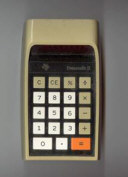
DATAMATH CALCULATOR MUSEUM
 |
DATAMATH CALCULATOR MUSEUM |
Texas Instruments announced on September 16, 1975 with the SR-52 their first Keystroke Programmable Handheld Calculator based on the TMS0500 Building Blocks for Scientific and Programmable Calculators introduced already in January 1974 with the SR-50 Slide Rule calculator. While the SR-50 used only the minimum configuration of this groundbreaking architecture combining the TMC0501 Arithmetic Chip and one TMC0521 SCOM (Scanning Read-Only Memory) Chip with the necessary display drivers for its 14-digit LED display plus power supply and clock generation, went the SR-52 a step ahead and made full use of the TMS0500 Building Blocks. The TI Programmable 59 nicknamed SR-52 II - was introduced in May 1977 as successor of the SR-52 and perfectly applied Moores Law integrating more memory capacity in smaller packages while lowering complexity. A closer look at the PCB (printed circuit board) of the TI-59 reveals a total of nine PMOS (P-channel Metaloxide Semiconductor) chips:
|
TMC0501E: Enhanced Arithmetic Chip Register Processor with five 16-digit Registers and segment decoder/driver TMC0582, TMC0583: TMC0580 Double Scanning and Read-Only Memory Chip 2.5k*13 Bits Instruction Memory with serial interface to Arithmetic Chip, 32 Constants with 16 digits, eight 16-digit Registers and 16-digit display scanning, each TMC0571: TMC0560 Bare Read-Only Memory Chips 1k*13 Bits Instruction Memory with serial interface to Arithmetic Chip for a combined 6k*13 Bits Instruction Memory TMC0594: Magnetic I/O Chip Four channel interface for magnetic card reader to save and load programs with up to 480 steps TMC0598*4: Four Multi-Register Chips 240*8 Bits Random Access Memory with 4-bit I/O Bus to Arithmetic Chip, stores 240 program steps or 30 numbers of 16 digits, each |
The TMC0598 Multi-Register Chip integrates 240*8 Bits RAM (Random Access Memory) storing 240 program steps or 30 numbers of 16 digits, each and accessible through a 4-bit bidirectional I/O bus. The design of the TMC0598 with one Chip Select (C.S.) and two Address pins (ADD0, ADD 1) allows for both compact designs with stacking two by two chips, each in a piggyback manner with cutting one of the two Address pins and large designs with an external address decoder activating the Chip Select pin:
| Address | TMC0598 Stack 1 | TMC0598 Stack 2 | ||
| Chip Position | Top Chip | Bottom Chip | Top Chip | Bottom Chip |
| ADD 0 | n.c. | VSS | n.c. | VSS |
| ADD 1 | n.c. | n.c. | VSS | VSS |
| C.S. | n.c. | n.c. | n.c. | n.c. |
| Active Bank | Bank 0 | Bank 1 | Bank 2 | Bank 3 |
Communication between the TMC0501E
Enhanced Arithmetic Chip to the TMC0598 Multi-Register Chip is realized with multiple means:
|
IDLE, PHI 1 and PHI 2
Signals are used to synchronize all peripherals connected to the TMC0501E
Enhanced Arithmetic Chip with the 16 States of its Instruction Cycle EXT Output indicates that the TMC0501E Enhanced Arithmetic Chip is addressing external memories/registers IRG Input to receive the 13-bit Instruction Words from the TMC0530/TMC0540/TMC0560/TMC0580 ROM Chips 4-bit bidirectional I/O Bus I/O 8, I/O 4, I/O 2, and I/O 1 to communicate with registers |
QUICK-LINK to TMS0500 Family.
| Calculator | Program steps | Data memory | TMC0599 |
| TI-58 | 0-480 | 60-0 | 2 |
| TI-59 | 160-960 | 100-0 | 4 |
| TI-5230 | t.b.d. | t.b.d. | 7 |
| Revision | Products | First Prototypes | Comments |
| TMC0598 | SR-52 II (TI-59) | November 1976 | Initial design Formerly TMC0599 Rev E |
| Item | Min | Typ | Max | Unit | Comments |
| VSS | 0 | V | |||
| VDD | -10.5 | -10.0 | -9.5 | V | |
| PHI1, PHI2 | 225 | 230 | kHz | Opposite phases |
The TMC0598 was manufactured in a 8 um metal gate PMOS process (metal width = 0.30 mil / 8.0 um, metal spacing = 0.30 mil / 8.0 um, diffusion width = 0.25 mil / 6.0 um, diffusion spacing = 0.35 mil / 9.0 um).
The die size of the TMC0598 is approximately 210 mils * 140 mils / 5.3 mm * 3.6 mm.
The TMC0598 uses a standard 0.3 wide 16-pin DIP (Dual In-line Package with a 0.1 / 2.54 mm lead pitch).
| Pin | IO | Function | Pin | IO | Function |
| 1 | V | Negative Voltage VDD | 16 | I | External access |
| 2 | I | Calculating status | 15 | I | CS (not connected) |
| 3 | I | Clock Input 1 | 14 | I | SAMP (not connected) |
| 4 | I | Clock Input 2 | 13 | O | Instruction words |
| 5 | IO | SCOM Interface D0 | 12 | I | Bank-Select 1 (VSS, nc) |
| 6 | IO | SCOM Interface D1 | 11 | I | Bank-Select 0 (VSS, nc) |
| 7 | IO | SCOM Interface D2 | 10 | IO | SCOM Interface D3 |
| 8 | V | Common Voltage | 9 | V | Negative Voltage VDD |
If you have additions to the above datasheet please email: joerg@datamath.org.
© Joerg Woerner, February 02, 2001. No reprints
without written permission.